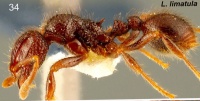Lordomyrma limatula
| Lordomyrma limatula | |
|---|---|

| |
| Scientific classification | |
| Kingdom: | Animalia |
| Phylum: | Arthropoda |
| Class: | Insecta |
| Order: | Hymenoptera |
| Family: | Formicidae |
| Subfamily: | Myrmicinae |
| Tribe: | Crematogastrini |
| Genus: | Lordomyrma |
| Species: | L. limatula |
| Binomial name | |
| Lordomyrma limatula Taylor, 2012 | |
Known only from the type collection, nothing is known about the biology of Lordomyrma limatula.
Identification
Taylor (2012) - Readily distinguished from other species discussed here by the relatively reduced sculpturation, which differs clearly from that of the somewhat similar Lordomyrma diwata.
Keys including this Species
Distribution
Latitudinal Distribution Pattern
Latitudinal Range: 10.66666667° to 10.66666667°.
| North Temperate |
North Subtropical |
Tropical | South Subtropical |
South Temperate |
- Source: AntMaps
Distribution based on Regional Taxon Lists
Indo-Australian Region: Philippines (type locality).
Distribution based on AntMaps
Distribution based on AntWeb specimens
Check data from AntWeb
Countries Occupied
| Number of countries occupied by this species based on AntWiki Regional Taxon Lists. In general, fewer countries occupied indicates a narrower range, while more countries indicates a more widespread species. |

|
Estimated Abundance
| Relative abundance based on number of AntMaps records per species (this species within the purple bar). Fewer records (to the left) indicates a less abundant/encountered species while more records (to the right) indicates more abundant/encountered species. |

|
Biology
Castes
Males have yet to be collected.
Nomenclature
The following information is derived from Barry Bolton's Online Catalogue of the Ants of the World.
- limatula. Lordomyrma limatula Taylor, 2012: 57, figs. 33-40 (w.q.) PHILIPPINES (Leyte).
Unless otherwise noted the text for the remainder of this section is reported from the publication that includes the original description.
Description
Worker
General features as seen in images. Conformation similar to Lordomyrma azumai. Vertexal margin weakly convex in frontal view; humeral nodules lacking; the mesosomal dorsal profile in lateral view almost straight: promesonotum barely raised above propodeal dorsum, metanotal groove relatively weakly depressed; propodeal spines proportionally a little shorter than in L. azumai. In side view the promesonotum rises sharply from the relatively narrow nucal collar. Mandibles smooth and shining, with a few very small piligerous punctures. Clypeus smooth and shining. Frons with scattered incomplete, slightly sinuous fine longitudinal costulae, the intervening surfaces largely smooth and shining, minutely weakly rippled in reflected light. Sides of head more densely sculptured, moderately rugose. Antennal scrobes shining, with quite strongly effaced traces of fine puncturation. Promesonotum smooth, shining dorsally, with moderately fine traces of effaced punctate-rugosity laterally and posteriorly, extending to dorsum and sides of propodeum. Nucal collar shining, almost without sculpturation. Propodeal declivity smooth, shining. Petiole and postpetiole somewhat obscurely transversely sculptured. Gastral dorsum smooth, shining, with relatively small, somewhat obscure stellae at the hair-bases, minutely microreticulate posteriorly. Anterior coxae brightly reflective with no trace of sculpturation; very weak traces of transverse striae on second and third coxae; legs otherwise smooth, shining, with minute piligerous punctures. Pilosity as seen in images. Color uniformly rich Siena-brown, antennae and legs a shade lighter. Dimensions: (Holotype, smallest paratype, largest paratype): TL 3.4, 3.0, 3.4; HW 0.76, 0.73, 0.78; HL 0.81, 0.79, 0.82; CI 94, 92, 95; EL 0.17, 0.15, 0.17; OI 22, 20, 22; SL 0.59, 0.56, 0.58; SI 78, 76, 74; PW 0.58, 0.56, 0.58; WL 1.03, 1.00, 1.04; DPW 0.21, 0.21, 0.22; DPpW 0.29, 0.27, 0.29; GW 0.74, 0.73, 0.81.
Queen
General features as seen in images. Dimensions (smallest paratype, largest paratype): TL 3.9, 4.0; HW 0.84, 0. 86; HL 0.85, 0.86; CI 99, 100; EL 0.23, 0.23; OI 27, 27; SL 0.57, 0.58; SI 68, 67; PW 0.61, 0.63; SW 0.70, 0.69; WL 1.19, 1.22; DPW 0.24, 0.24; DPpW 0.30, 0.31; GW 0.93, 0.92.
Type Material
PHILIPPINES: LEYTE: Lago-lago River, Leyte State University, Baybay (Coordinates for Baybay City are: 10°40'N, 124°49'E). Known only from the type series, comprising the holotype, 13 worker paratypes, and 11 paratype gynes. PHILIPPINES: LEYTE: Lago-lago River, Leyte State University, Baybay (H. Zettel & C. Pangantihon, 19. 3. 2005). Holotype, paratype gyne: University of the Philippines Los Baños. Paratypes: Australian National Insect Collection: 2 workers, 2 gynes; Naturhistorisches Museum Wien, Vienna: 2 workers, gyne; USCP: worker, gyne. Remaining paratypes Herbert and S.V. Zettel.
Etymology
The name refers to the polished promesonotum of this species.

